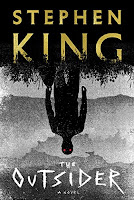Algorithms to Live By: The Computer Science of Human Decisions, by Brian Christian & Tom Griffiths
>> Tuesday, June 26, 2018
TITLE: Algorithms to Live By: The Computer Science of Human Decisions
AUTHOR: Brian Christian & Tom Griffiths
COPYRIGHT: 2016
PAGES: 368
PUBLISHER: Henry Holt and Co.
SETTING: N/A
TYPE: Non-Fiction
SERIES: None
Algorithms are basically a set of rules that tell you how you can solve a type of problem. We're most familiar with their use in computer science, and the intriguing idea behind this book is to look at how algorithms are used in that area and see if they can be used to solve similar kinds of problems in everyday life.A fascinating exploration of how insights from computer algorithms can be applied to our everyday lives, helping to solve common decision-making problems and illuminate the workings of the human mind
All our lives are constrained by limited space and time, limits that give rise to a particular set of problems. What should we do, or leave undone, in a day or a lifetime? How much messiness should we accept? What balance of new activities and familiar favorites is the most fulfilling? These may seem like uniquely human quandaries, but they are not: computers, too, face the same constraints, so computer scientists have been grappling with their version of such issues for decades. And the solutions they've found have much to teach us.
In a dazzlingly interdisciplinary work, acclaimed author Brian Christian and cognitive scientist Tom Griffiths show how the algorithms used by computers can also untangle very human questions. They explain how to have better hunches and when to leave things to chance, how to deal with overwhelming choices and how best to connect with others. From finding a spouse to finding a parking spot, from organizing one's inbox to understanding the workings of memory, Algorithms to Live By transforms the wisdom of computer science into strategies for human living.
I always say that I became an economist not because I was particularly interested in the topic, but because I discovered that the economics logic (such as optimisation, cost-benefit analysis) chimed really well with the way my mind already worked and the way I tended to make decisions even about private matters. So the topic of this book was extremely attractive to me.
The best way to explain what the book is like is probably to give you an example. So, one of the first issues they look at is the problem of optimal stopping. Say you are looking for an X, and there are many candidates available for you to choose. You want to choose as good an X as possible. You know what a good X looks like, but you have no idea what level of quality you might expect from the field of candidates available to you. They might all be excellent X, or there might be 1 or 2 that are ok, and all the rest crap. Furthermore, you have to examine each potential candidate before you know their quality -that is, you can't deduce what they'll be like beforehand. So all you can do is choose candidates in random order and examine them to see how good an X they might be.
In the purest version of the problem, you have to decide right after you've seen each candidate whether you'll chose it or not, and if you decide to keep on examining further candidates, you can't go back to the one you've rejected.
So there clearly is a conflict here between needing to see enough candidates to have an idea of the quality of the field (and whether it's worth holding out for an outstanding candidate or just settling for an ok one) and needing to nab a good candidate before it becomes unavailable to you. If you choose too soon, you miss out on a potentially excellent candidate. If you keep examining more and more, you run the risk that you'll have to end up settling for a mediocre one, just because it's the only one left.
This is a classic problem which is often called the Secretary Problem. As in hiring secretaries (can you tell this issue was originally popularised in the 1950s?). And the problem actually has a mathematical solution. It can be proved that the best strategy is to examine the first 37% of the available candidates without making a choice (even if you find one that seems to you to be the perfect secretary). Once that is done, you continue examining candidates until you find one that is better than the ones you've seen. As soon as you do, you hire them.
Not a wholly realistic situation, of course, but close enough to one I found myself facing when moving to Helsinki. I needed to find somewhere to live. Completely new city and country, so I had very little idea of what the field of available flats was like. Yes, I did have some indication of quality from the online listings, but it's surprising how deceptive those photos can be. And of course, flats didn't magically become unavailable as soon as I'd visited them if I didn't decide straight away, but the good ones do have a tendency to be snapped up really quickly by someone else if you dawdle!
So I decided to apply the algorithm in my search. There wasn't a limited field of candidates, but the book suggested that the 37% figure can be applied either to the number of candidates or to the time available to search. Bingo. I had booked myself a studio flat on airbnb for the first month, with an aspiration to move into a new place on March 1st. So that gave me 11 days to just look, holding back from making any decisions, after which I'd either go for the best I had seen if it was still available (bending the rules slightly), or for the first one I found that was better than the ones I'd seen.
So I did just that. It was hard. The first flat I saw, only on day 2 of the search, I really liked. Good location, excellent layout, bright, with high ceilings, and just within my price range. But I held my nerve, even while I didn't really find anything that great for a while. Even when I saw that nice flat from cay 2 disappear from the online listings, clearly taken by someone else. After day 11, I went on decision mode, and still nothing. Until on day 19, I found the right place and went for it straight away, with zero doubts. My 'wait and see' period had given me the assurance that I knew what the field was like, and so I could be confident that I was making a good choice and that there was little chance that I was missing out on something better. I moved in on March 1st, and I love the place.
Anyway, this is just one chapter of the book. There are quite a few more, and pretty much all of them were just as fascinating and illuminating. In many cases, the point was no so much the algorithm that solved the problem, but the setting out of the problem itself. I kept going "huh, I never thought of that in quite that way!". Although not all chapters were as useful to me in a practical sense as the one on optimal stopping, several of them made me look at things in a different way. In some cases they made sense of something I was intuitively doing, in others they made me adjust my behaviour (when I went back to visit friends in Liverpool a couple of weeks ago I decided to go to my favourite restaurants there, rather than to try the intriguing-sounding new place, based on the chapter on explore/exploit decisions).
The authors have an excellent, accessible way of explaining quite complex topics, and their extrapolations from the abstract into everyday life situations made sense. Yes, some do work better than others and are more intuitively applicable, but on the whole, they really worked.
I loved this book. I'd recommend it to anyone, even if you don't have an interest or background in computer science or maths.
MY GRADE: An A-.









0 comments:
Post a Comment